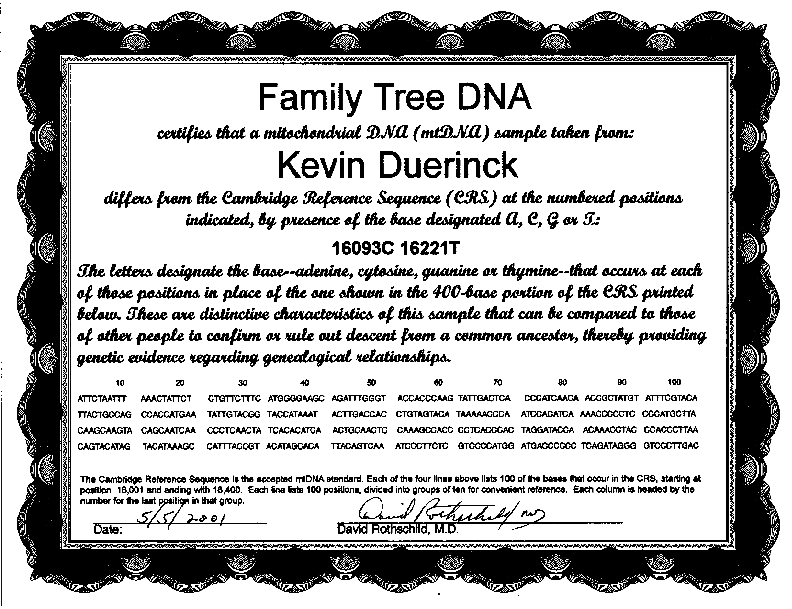

KEVIN DUERINCK
SURNAME DNA PROJECT
mtDNA TEST RESULTS

Welcome to the DUERINCK SURNAME DNA PROJECT
[LAST REVISED October 17, 2006 (Link to The H mtDNA Haplogroup Project)]
On May 10, 2001 I received the mtDNA results for participants who wanted the mtDNA test. An image of the FTDNA mtDNA certificate for me is below. I did the analysis. First of all, though, an introduction is in order.
mtDNA: Mitochondrial DNA is DNA found in a mitochondrion. Mitochondria are organelles, if you will, that harness the majority of the usable energy from a simple sugar molecule. Individual mtDNA molecules are small and usually circular. Mitochondrial genomes are also characterized by a very high mutation rate.
Note: It has always been assumed that mtDNA is inherited by sons and daughters only from the mother. A new 2002 study [Marianne Schwartz and John Vissing from the University Hospital Rigshospitalet in Copenhagen, Denmark; New England Journal of Medicine (vol 347, p576)] showed that mtDNA can be inherited by both parents. This appears to be a very rare event. See Paternal mtDNA

As you can see from the HVRI mtDNA certificate from Family Tree DNA, I differ from the Cambridge Reference Sequence (CRS) at 16093C and 16221T. While there are over 16,500 base pairs of genetic mtDNA material, it is easier to take a small area, such as the hyper variable control region 1 (HVR-1), and compare our results to it. So scientists took the 400 base pair area of HVR-1, called it the Cambridge Reference Sequence, and now compare the mtDNA results of people to it. I found that my haplogroup assignment (cluster) is H. This is the Helena Clan that Prof. Sykes of Oxford Ancestors talks about. The diagnostic motif for H: HVR1 motif is CRS; 73 status is A; coding region mutations are -7025 AluI, +11718HaeII, -14766MseI. The founder cluster to which each sequence type is assigned was h00 at f0 through fs'. The frequency of the sequence type in European sample was 8. Looking at the European tables, I found that for Haplogroup H at 093 221, that 3 samples studied in the literature were Alpine Europeans, 1 was North Central European, and 4 were from North Western Europe.
--One can also go to the Mitochondrial DNA Concordance [HVR 1 Concordance, Version 2.0 (1998)]. Armed with this information, I found 2 Swiss (germanic) people had the same differences from the CRS--namely at 16093C and 16221T:
Pult,94; SW19; Swiss(1)
Pult,94; SW43; Swiss(1)
HVR2 mutations: I received the results of my test for the HVR2 region of mitochondrial DNA on October 15, 2002. My variants from the Cambridge Reference Sequence (CRS) are 263G and 315.1C and, since the majority of humans have both of these variants, neither is especially informative. What is informative is that I lack the variant from the CRS at position no. 73 and this means that I have an 'A' at that site which is typical of haplogroup H (& V) sequences.
TIME FRAME TO COMMON ANCESTOR
The chart below shows the time frame to the common ancestor for a random match.
Test....................Time frame of common ancestor for a match
==========....==================================
mtDNA................50% of the time, 52 generations or less
mtDNAPlus........50% of the time, 28 generations or less
These time frames are for random matches. If you have identified the ancestors or potential ancestors, then you cannot use the time frames shown above because you would not have a "random" match.
MY MATERNAL ANCESTOR SURNAMES
Patricia Ann Bird is my mother, her mother Theresa Guschke was German; Teresa Guschke's mother was named Theresa Weichbrod(t), b. 5 March 1869, Danzig, West Prussia, Germany (now Gdansk, Poland), d. 10 Nov 1933, Chicago, Cook Co. Illinois. Theresa Weichbrod(t)'s mother was Amalia Monica Wiersbitzki, b. 4 May 1834, Braunsburg, Germany, d. 5 May 1909, Chicago, Cook Co., Illinois. Amalia's mother was Anna Plath. For Plath, we have no further information. Someday, if there is more time, one could join one of the Rootsweb or GenForum message boards, specifically the Plath one, and put out this information to find if there are any connections out there.
The H mtDNA Haplogroup Project [to explore the individual identity of each H mtDNA sub-clade]
Oxford [To find your maternal haplogroup]
Oxford [mtDNA article on settling of Europe]
Oxford [another mtDNA article]
Mitochondrial DNA Concordance--Table of Contents [HVR 1 and 2]
Mitochondrial DNA Concordance [HVR 1 Concordance, Version 2.0 (1998)]
Mitochondrial DNA Concordance [HVR 2 Concordance, Version 2.0 (1998)]
Map of Human mtDNA Migrations/Haplogroups (map used to be on Emory Univ. site)
Duerinck Surname y-DNA Project Results
Why DNA Testing For Genealogy and How To Manage It
Surname DNA Project Waiver/Release Form
State of Illinois Genetic Information Privacy Act -- Selected sections
Short Tandem Repeat (STR) Analysis
Medical Genetics and Genealogy: Genetic Diseases
Genetics and Human Migration Patterns
Kerchner Mitochondria DNA Test Results Log Book
Mumma Surname DNA Project [results in]
Stidham Surname DNA Project [results in]
Cuni Surname DNA Project [results in]
Wells Surname DNA Project [In design phase]
Brigham Young University DNA Project [current project will yield a huge database of results]
The Seeker, a DNA Project for Adopteds and Birth Parents
RootsWeb Genealogy-DNA ListServe [where we all hang out, or is that lurk?]
Biotech Shares [Check out the DNA Story link and others]
Scylla's Genetic Links [includes databases, mapping, sequencing]
SNP Consortium [856,666 mapped SNPs; 607 are y-SNPs in 8th data release]
National Center for Biotechnology Information database [dbSNP--3 million SNPs]
How to DNA Test Our Family Relationships, by Terrence Carmichael and Alexander Kuklin (AceN Press, Mountain View, California 2000) How to DNA Test book here
DNA for Family Historians, by Alan Savin Savin DNA book here
SNP and Microsatellite Genotyping: Markers for Genetic Analysis (Molecular Laboratory Methods Series), Edited by Ali H. Hajeer, PhD, University of Manchester, UK. Forthcoming Fall 2000, $48.95, Hardcover, 172 pp, Color insert; ISBN 1-88129-38-4. See Here [Talk about high-throughput!: MADGE, SNP, Microsatellites, High-Throughput]
Copyright © 2001-2006 Kevin F. Duerinck